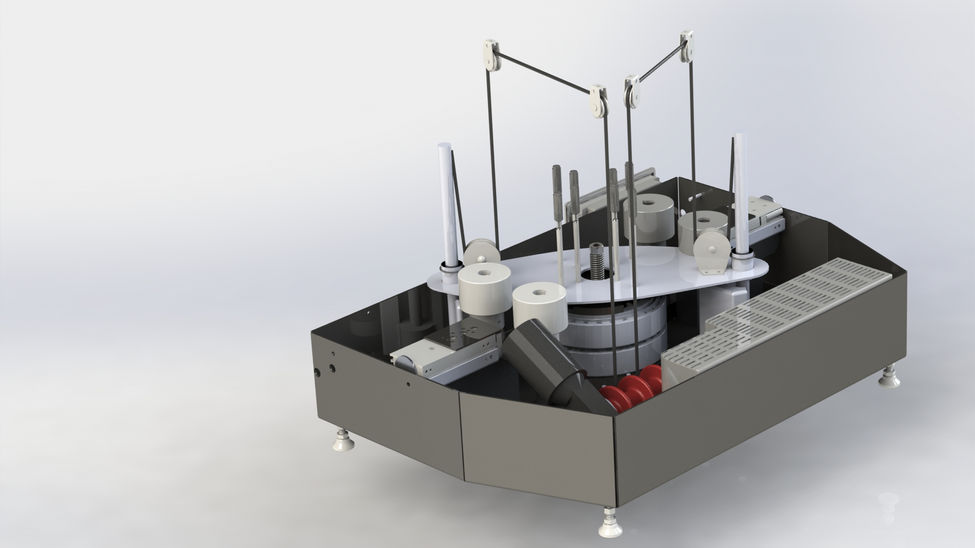Engineer with Passion

SENIOR
CAPSTONE

Personal Tasks
-
Design a bearing conditioning machine for a local corporation
-
Design electrical system including PLC connections, safety systems, component selection, etc.
-
Design mechanical systems
-
Guarantee machine is manufacturable and meets client requirements

Hard Skills
-
Tight-tolerance design
-
Solidworks
-
AutoCAD Electrical
-
Machine Design
-
Matlab
-
Wire & PLC Diagrams
-
2D Drawings
-
3D Printing
-
Budgeting
-
Bill of materials
-
Adobe Illustrator

Soft Skills
-
Meeting client expectations
-
Teamwork
-
Project management
-
Communication with clients
-
Troubleshooting
-
Verification
-
Design validation
-
Time management
Four mechanical engineering students were assigned to design a machine for a company that builds conveyor systems. This was the need:
-
Conveyor systems use a lot of bearings
-
These bearings came to our client disassembled
-
When the bearings are first assembled, the parts don't seat together perfectly because the grease is very thick
-
Bearings must therefore be spun back-and-forth by-hand until the parts seat together properly, within a tolerance of 0.0009"
-
This process can sometimes take hours, client desired automation
The client desired a machine that could do the following:
-
User inserts a bearing into the machine and uses a touch-screen to select settings, such as which bearing was inserted
-
Machine spins the bearings and measures bearing height iteratively, until bearings are satisfactorily seated within 0.0009" tolerance

Exploded view of final design
-
Machine must have safety features such as error-catching if something goes wrong, signal lights, safety doors, soft and hard kill switches, etc.
-
Machine must be controlled by a PLC and programmed in Ladder Logic, so techs can make modifications as desired
-
Stay within a $10,000 budget
We were an all-mechanical engineering team with no experience in electronics, high-precision sensors, touch-screens, or programming outside of Matlab, Arduino, and in my case, RobotC.
I assumed the role of electromechanical engineer. I learned about PLCs, designed the wiring for the entire machine, and designed mechanical components as-needed. This included not only design but component selection, maintaining a bill of materials, and budgeting as well. I also designed the team poster used in our final presentation.

Wire Diagram
My largest singular contribution was design of the wiring diagram, pictured below. It contains a PLC, sensor wires, power wires, emergency-shutoff, ethernet connection to sensors, motors, pneumatic valves, motor controllers, and a signal light. I am pleased how it turned out, considering I entered this project not knowing the first thing about wiring, wire diagrams, standards, PLCs, etc. outside circuits learned in mechatronics class. I designed using AutoCAD Electrical, and the differences between that software and typical AutoCAD surprised me. Most of the professors I met who had familiarity with PLCs only knew how to program them, so in a lot of ways I was on my own. Our client's electrical engineering department was ultimately pleased with the diagram and said they fully intend to wire as-drawn with only a few minor changes. Not bad for a mech-e who was building a racecar at the same time!
Mechanical Design
I designed a mechanical lift for raising and lowering high-precision measurement probes. This lift was required to:
-
Raise the probes while the bearing was being spun
-
Lower the probes for measurements while bearing was not spun
-
Not lose precision between measurements. In other words, the probes' vertical placement could not differ by more than 1/10,000th of an inch between measurements
My lift system accomplished all of this as follows:
-
Probes are mounted to a rigid plate
-
Plate is free to move up and down on high-quality linear guides
-
Plate is lifted and lowered using a pulley system
-
In the down (measurement) position, plate is placed on a finished surface with some slack in the pulley, so the height of the plate will be exactly the same every time
-
This was cheaper and more precise than specifying precision actuators to raise and lower the sensors
Unfortunately the Coronavirus pandemic halted production of our machine, but the client loved this design and is fully intent on building it within the upcoming year, whenever their own production slows down and their machine shop has availability.






